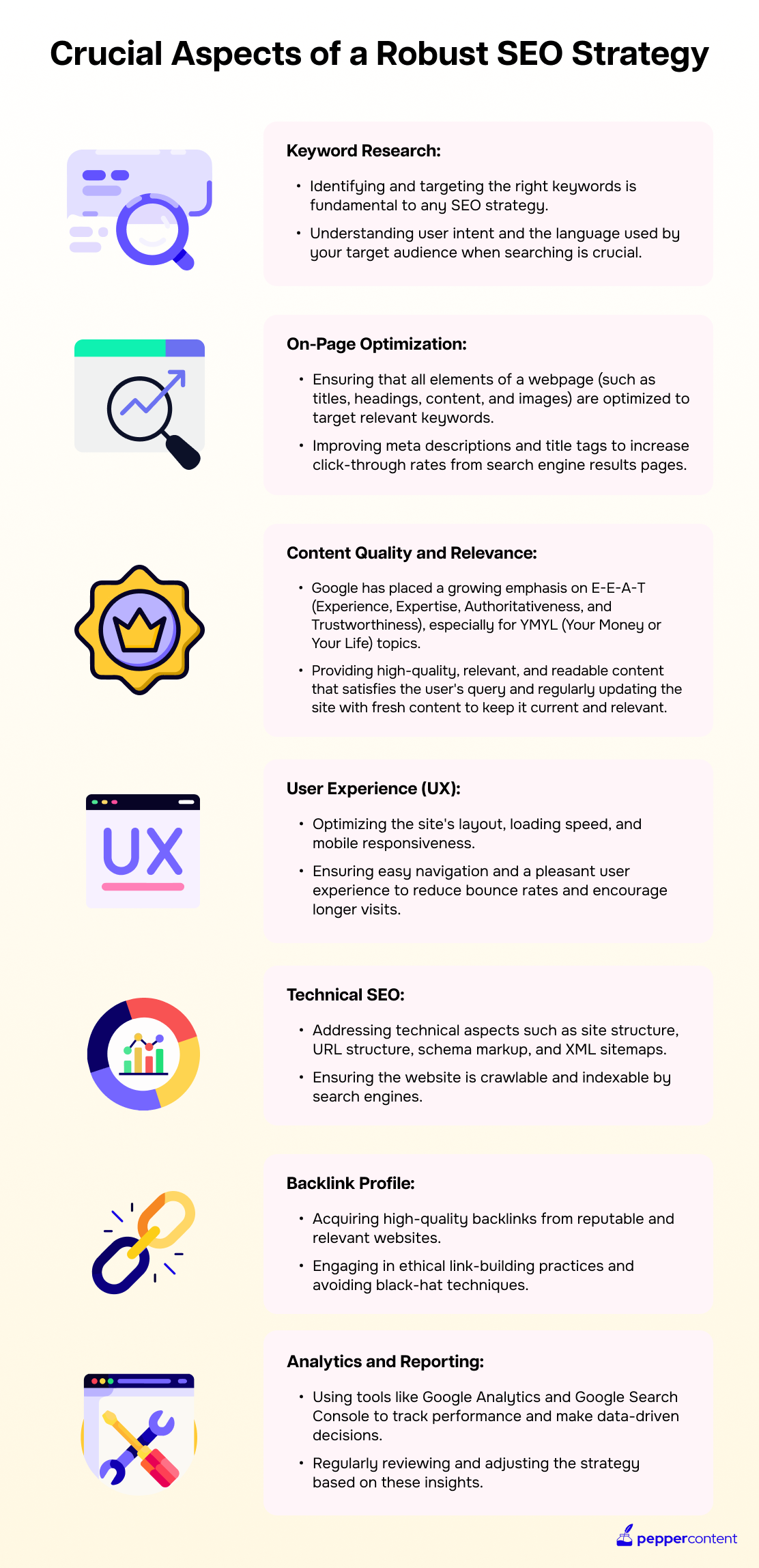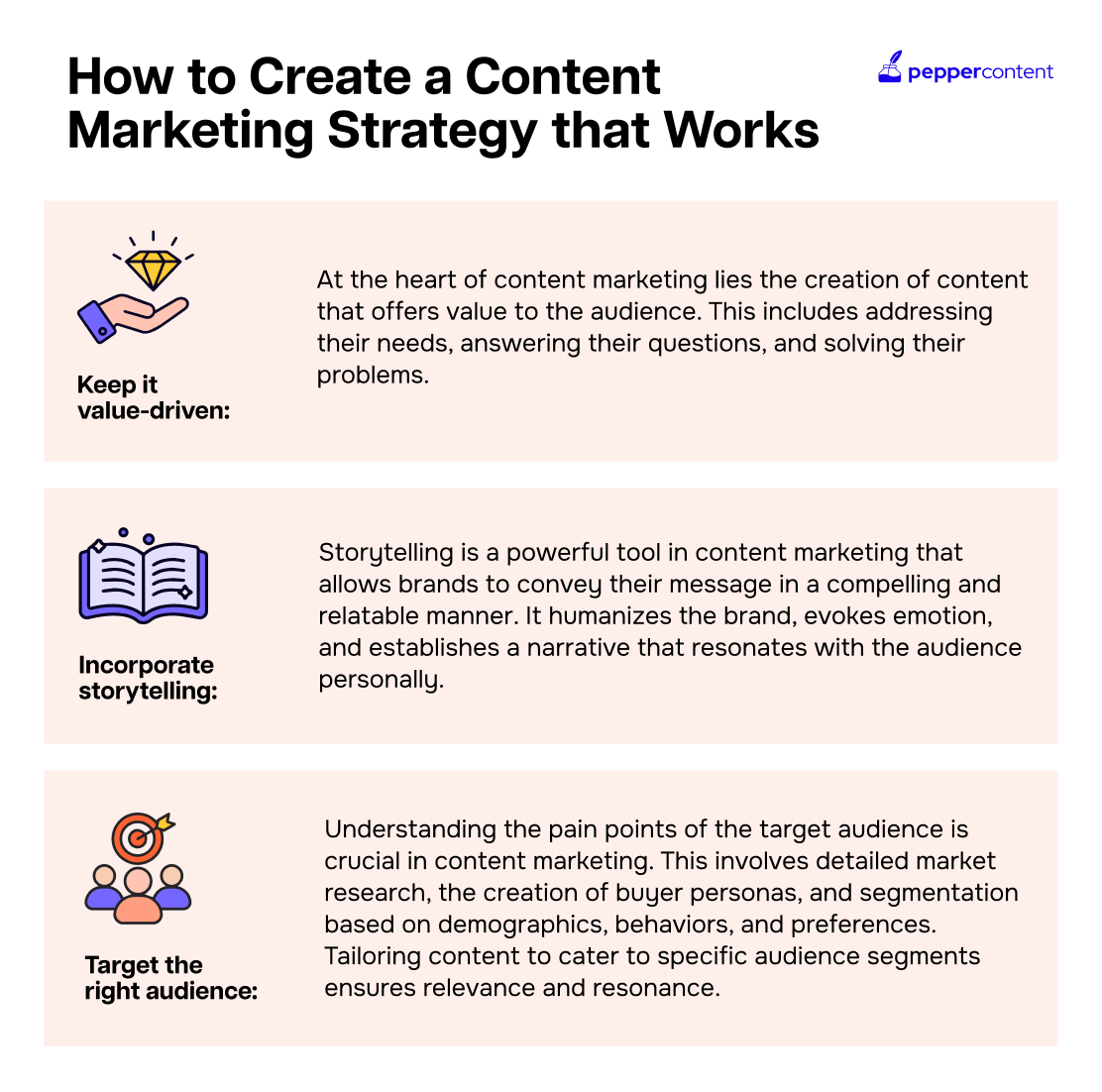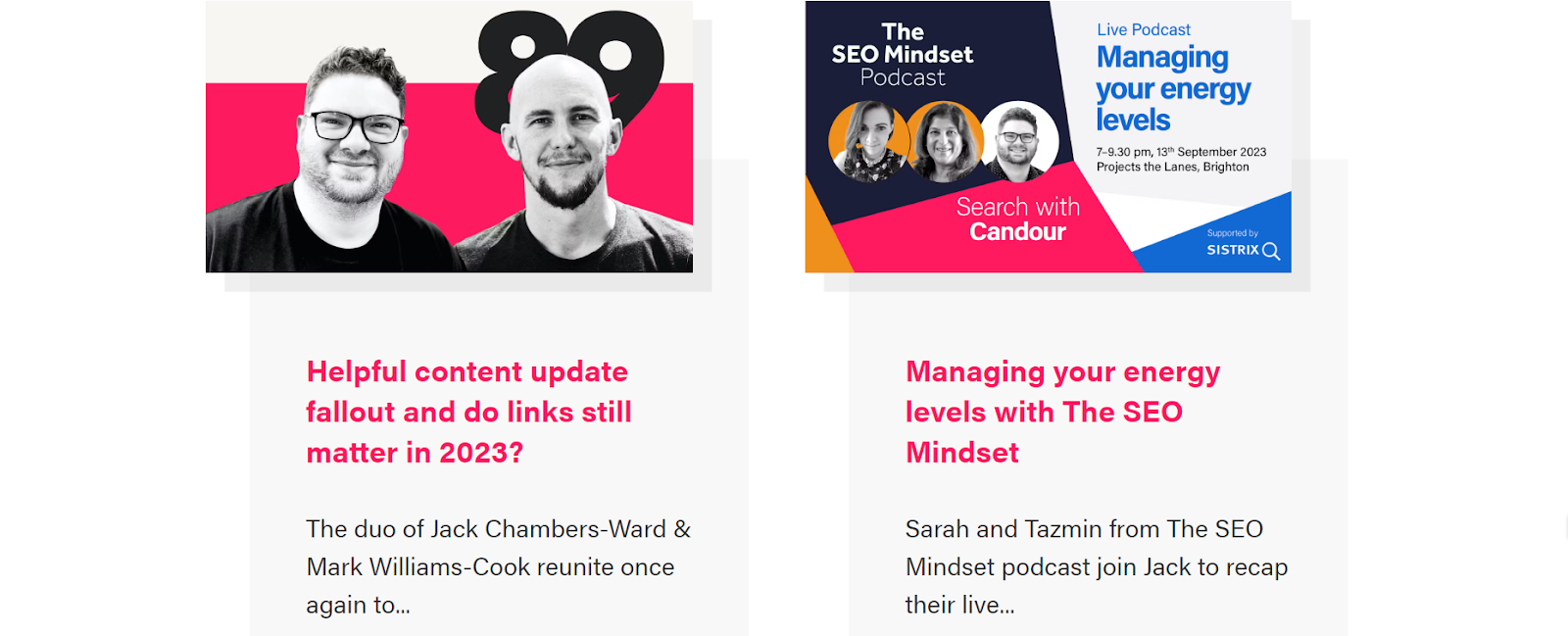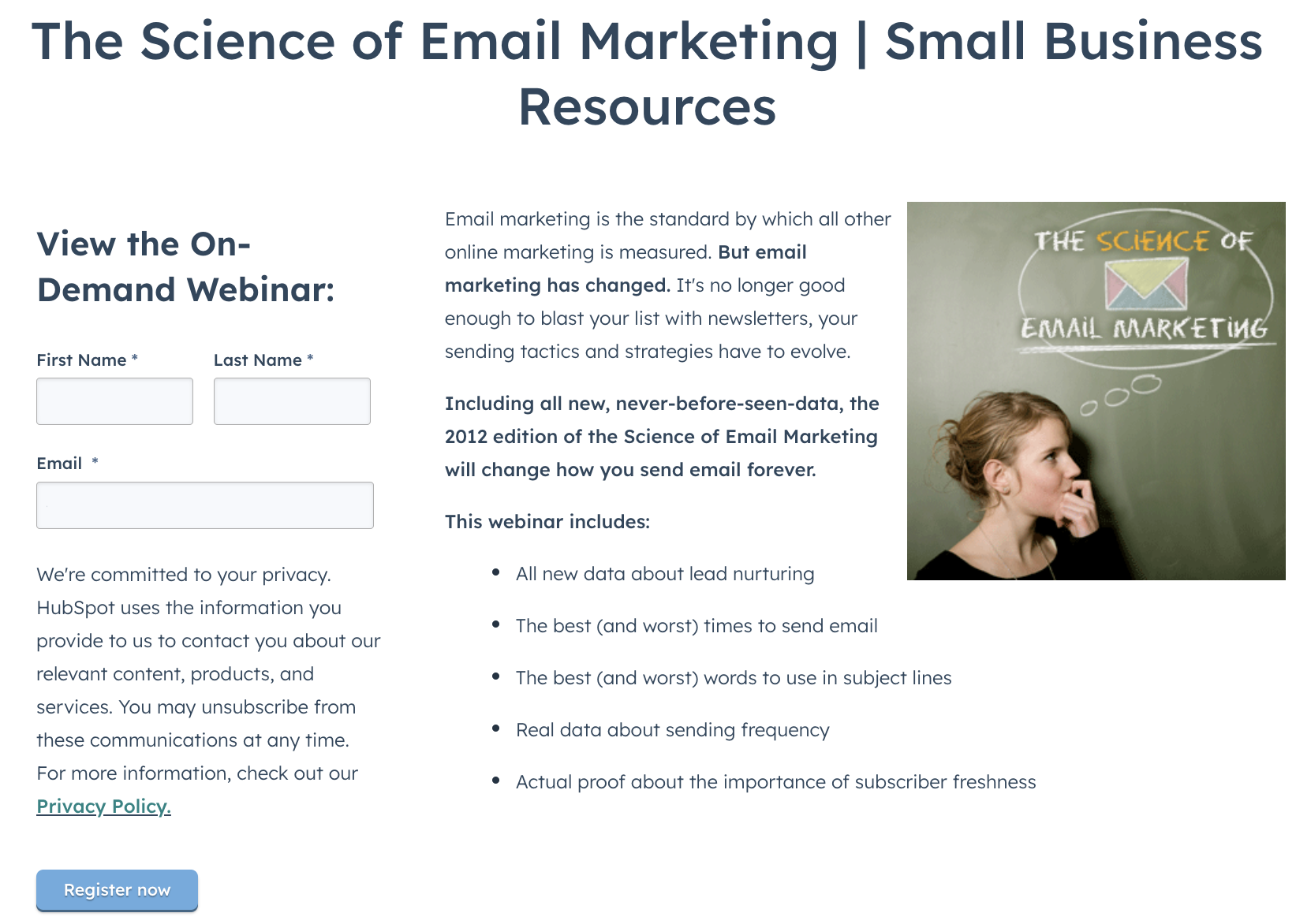How To Find a Balance Between SEO and Content Marketing

When it comes to online marketing, SEO and content marketing stand as indispensable pillars for any brand striving to survive the highly intense competition. As search engine algorithms continue to evolve, understanding the complex interplay between SEO and content marketing is crucial for success.
By understanding how these two strategies interact, businesses can unlock the full potential of their online presence. Having said that, this article navigates through the dynamic partnership between effective SEO and content marketing, offering invaluable insights and practical tips on maintaining a balance between these techniques.
Let’s get started!
Understanding the Basics
Before looking at how to balance between these two techniques, let’s begin with the basics.
SEO (Search Engine Optimization)
Search engine optimization, or simply SEO, is the process of optimizing a website’s technical configuration, existing content, and link popularity to improve its visibility and ranking on SERPs. This includes strategically using relevant keywords in key elements such as titles, meta descriptions, and headers (H1, H2, etc.).
Additionally, it includes the optimization of URLs for clarity and search relevance, opting for descriptive phrases instead of numerical strings, and schema markup to further refine the context of the page’s content, along with a spectrum of SEO best practices.
For many people, the term “search engine” is practically synonymous with Google, which has a staggering 83% share of the global search engine market. Given Google’s dominance, SEO strategies are predominantly tailored to align with its algorithms and preferences.
Now, in SEO, we sometimes prioritize only one aspect of optimization efforts over others. But as Google’s John Mueller explains in this video, there isn’t a single important aspect that will pull insanely high rankings out of thin air. Instead, we must focus on a comprehensive SEO strategy.

Content Marketing
Content marketing is precisely what the name implies — using content as a compelling tool to market your brand.
It is a strategic marketing approach that revolves around creating and distributing valuable, relevant, and consistent content to attract and engage a specific target audience. It is a dynamic process that goes beyond traditional marketing, focusing on
building long-term relationships and trust with customers.
Organic marketing strategies, such as content creation and SEO, may require a patient approach to realize their potential and deliver results fully. However, once they’re up and running, they become an engine for continuous growth.
Whether you choose the basic blog format or experiment with other things like producing viral videos, hosting podcasts, asking for user-generated content from valued customers, or crafting visually striking infographics, the versatility of content allows it to adapt to your specific needs and demands seamlessly.

The Intersection of SEO and Content Marketing
The relationship between SEO and content marketing is symbiotic, each playing a crucial role in enhancing a brand’s online presence.Content marketing provides the substance and material that SEO leverages to optimize a website’s visibility and relevance in search engine results.
Quality content serves as the foundation of effective SEO strategies. It provides the relevant and valuable information that users seek, making it a prime target for search engine algorithms. For instance, a well-researched blog post addressing FAQs in a specific industry not only educates the audience but also contains keywords that improve the page’s visibility.
Take the case of Moz; they consistently produce high-quality, informative content on various aspects of digital marketing. This content not only educates its audience but also serves as a trove of valuable information that naturally attracts organic traffic.
Quality Content: A Cornerstone of Ranking and Engagement
Google’s algorithms have become increasingly sophisticated, prioritizing content that provides genuine value to users. High-quality content not only meets these algorithmic requirements but also fosters user engagement.
Engaging content captivates readers, encourages longer page visits, and reduces bounce rates, positively impacting SEO rankings.
Neil Patel is a prime example of a thought leader who excels in producing high-quality content that aligns with Google’s emphasis on user value and engagement. Through his extensive blog, podcasts, and videos, he combines thorough research, data-driven insights, accessibility, actionability, and a multi-format approach to deliver content that not only meets Google’s algorithmic requirements but also captivates readers and encourages longer engagement — all of which contribute to positive SEO rankings and a strong online presence.
Striking the Right Balance
In online marketing, finding the right balance is essential for success. Let’s explore key strategies to ensure your content resonates with your audience while maintaining optimal visibility in search engine results.
1. Quality Over Quantity
Prioritize the creation of high-quality content that deeply resonates with your target audience. This includes providing valuable information, unique insights, and engaging storytelling.
For example, Mark Williams-Cook is a well-respected figure in the SEO community. He founded the digital marketing agency Candour and hosts the “Search with Candour” podcast. Mark is known for his deep technical knowledge of SEO and his ability to simplify complex concepts for a broader audience.

Additionally, avoid keyword stuffing and, instead, include keywords organically and seamlessly into your content to maintain its authenticity and readability.
2. Research-Driven Content Creation
Leverage tools and analytics to thoroughly research your audience’s needs, interests, and pain points. This data-driven approach ensures that your content addresses specific challenges or queries your audience may have.
Strive to strike a balance between satisfying user intent and meeting search engine requirements. This means creating content that not only provides value but is also structured and optimized for search visibility.
3. Technical SEO Considerations
Pay close attention to technical aspects of SEO that can impact content delivery. Ensure your website’s speed is optimized and mobile-friendly to provide a seamless user experience.
Here are some examples of technical SEO considerations:
- Website Speed Optimization: Implementing strategies to improve page loading times, such as optimizing images, leveraging browser caching, and minimizing server response times.
- SSL Certificate and HTTPS: Securing the website with an SSL certificate to enable HTTPS, which is important for data security and trustworthiness and is also a ranking factor for Google.
- Crawlability and Indexability: Ensuring that search engine bots can easily crawl and index the content on your website. This includes proper use of robots.txt files, XML sitemaps, and canonical tags.
- URL Structure: Creating clean, descriptive, and user-friendly URLs that are easily understandable by both search engines and human visitors.
- Schema Markup: Implementing structured data using schema markup to provide additional context to search engines about the content on your pages. This can lead to rich snippets in search results.
- Canonicalization: Setting canonical tags to indicate the preferred version of a page when there are multiple versions of similar content helps prevent duplicate content issues.
- Optimized Images and Multimedia: Compressing images, using appropriate file formats, and providing alt tags and descriptive captions to enhance accessibility and improve page load times.
- Fixing Broken Links and 404 Errors: Regularly checking for and resolving any broken links or 404 errors to ensure a smooth user experience and prevent negative impacts on SEO.
Implementing these elements can enhance the presentation of your content in search results, making it more appealing to users.

4. Evolving With the Landscape
Staying abreast of the latest developments is vital for maintaining a competitive edge.
Search engines like Google continually refine their algorithms to provide users with the most relevant and high-quality search results. These algorithm updates can have a significant impact on website rankings.
For instance, Google’s Core Web Vitals update, which focuses on user experience metrics like page load speed, is a recent example. Adapting to these changes requires web admins to regularly monitor industry news, attend conferences, and participate in forums and communities where SEO experts share insights.
Similarly, understanding the evolving preferences and behaviors of the target audience is crucial for creating content that resonates. This involves conducting regular audience research, analyzing user data, and leveraging feedback mechanisms.
Platforms like TikTok have gained immense popularity in recent years, especially among younger demographics. Adapting content strategies to include short-form videos or interactive challenges can help businesses tap into this trend and connect with a broader audience.
Practical Tips to Maintain the Balance
Now, let’s dive into these practical tips for balancing SEO and content marketing strategies.
1. Regular Content Audits
Conducting regular content audits is a fundamental practice in maintaining a well-balanced SEO and content marketing strategy. This involves a systematic review of all existing content assets to assess their performance in terms of SEO metrics and user engagement.
You might wonder, why bother with the stuff that’s already done? Well, auditing your current content helps you:
- Figure out what’s working and what your target audience likes.
- Identify what’s not working so you can avoid it in the future.
- Identify gaps in the types of B2B content you create and the topics you cover.
- Make sure you’re not accidentally repeating the same content on your site.
Remember, a casual look won’t give you the complete picture. To understand how good your content is, you must evaluate each page using a set of standard measures. This way, you’ll get a clear view of what’s happening.
2. Investing in Continuous Learning
Given the dynamic nature of SEO and content marketing, investing in continuous learning is essential. You can participate in online courses, workshops, or certifications from reputable platforms and institutions. These courses cover various topics, from keyword research to content optimization.
Following authoritative blogs, newsletters, and forums also keeps you informed about the latest developments and trends in the SEO and content marketing space.
Additionally, engage with industry experts and thought leaders through webinars and workshops.
Over 99% of B2B marketers say webinars are key to their future marketing strategy. One brilliant example is HubSpot’s webinar titled “The Science of Email Marketing.” This free, hour-long webinar imparts valuable insights and actionable tips for crafting successful email marketing campaigns.

3. Collaborating with Experts
Collaborating with experts can be a strategic move as they bring specialized knowledge and skills to the table, enhancing the effectiveness of your efforts.
This could involve:
- Hiring an SEO Specialist: Employing an in-house SEO professional or contracting an agency can provide dedicated expertise in optimizing your content for search engines.
- Partnering with Content Creators: Collaborating with skilled writers, videographers, influencers, or designers ensures that your content is of high quality and aligns with SEO best practices.
4. Monitoring and Adapting to Analytics
Once your content is up and running, it’s crucial to see if your B2B content marketing strategy adheres to the best SEO practices and is paying off. Analytics tools provide valuable insights into content performance and user behavior.
Here’s how to effectively use them:
- Google Analytics: Track key metrics such as page views, bounce rates, session durations, and conversion rates. This data helps in evaluating content engagement and identifying areas for improvement.
- Google Search Console: Gain insights into how your content is performing in search results. Monitor impressions, clicks, click-through rates, and keyword rankings to refine your SEO strategies.
- A/B Testing and Experimentation: Use A/B testing to compare different content variations and assess which performs better in terms of user engagement and SEO metrics.
By implementing these practical tips, businesses can maintain a balanced approach between SEO and content marketing, ultimately driving sustainable growth and success in the digital landscape.
What’s Next?
Finding the right balance between SEO and content marketing requires continuous effort and adaptation. By recognizing the relationship between these two strategies, businesses can unlock the full potential of their online presence.
Remember, quality content is the cornerstone of any successful digital marketing campaign, while SEO is the compass guiding it toward the right audience. Through regular audits, ongoing education, collaboration with experts, and leveraging analytics, businesses can navigate this landscape with confidence.
If you require expert assistance in SEO content creation, Pepper Content is here to help. We’re dedicated to helping you understand your target audience and crafting content that fits your business requirements. Consider us your all-in-one solution for all things content! Don’t hesitate to book a demo today!
Latest Blogs
Explore how Google’s 2025 AI search updates triggered ranking chaos. Learn actionable strategies to adapt your SEO for AI Overviews, zero-click searches, and SERP volatility. Stay ahead now.
Learn how to rank on AI search engines like ChatGPT, Perplexity, and Gemini by optimizing your content for authority, structure, and relevance. Stay ahead in AI-driven search with this strategic guide.
Explore the best healthcare SEO services for your medical practice. Improve online visibility and effectively reach more patients in need of your services.
Get your hands on the latest news!
Similar Posts

Content Strategy
5 mins read
Choosing The Best Healthcare Marketing Agency For Effective Content Solutions

Content Marketing
4 mins read
Top 10 Agencies B2B SaaS Content Marketing for B2B Success

B2C Marketing
5 mins read